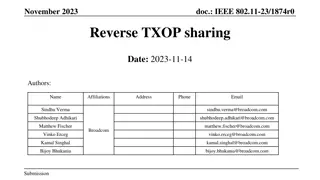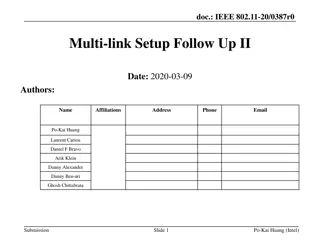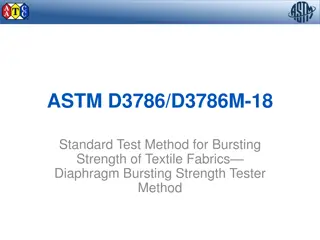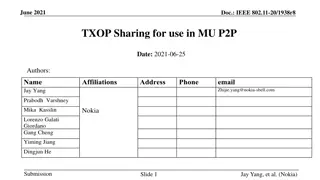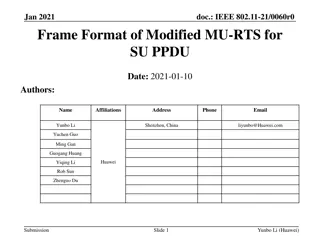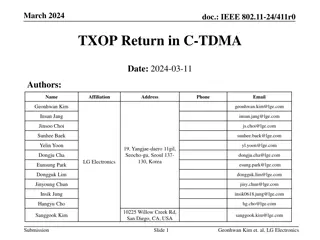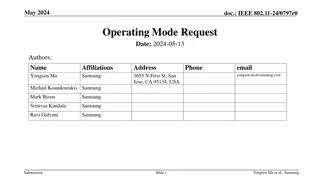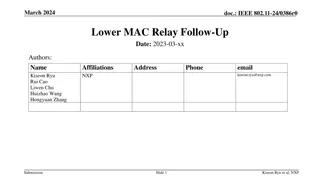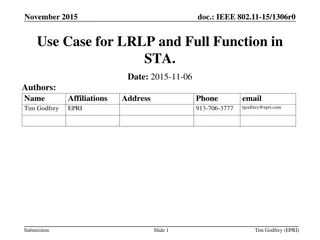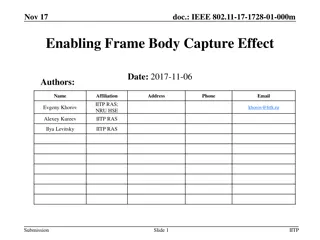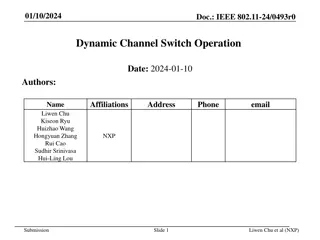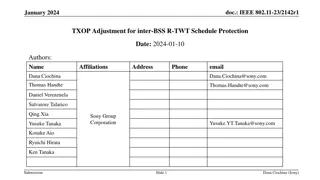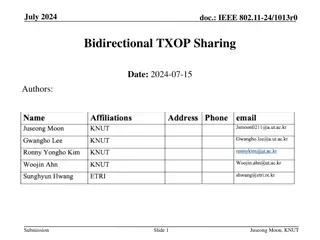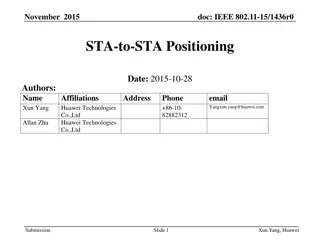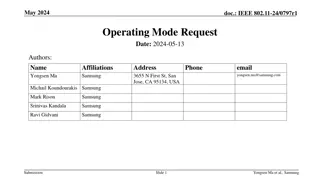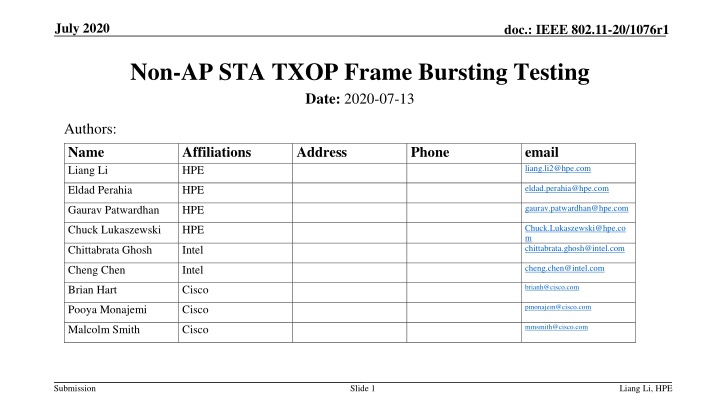
IEEE 802.11-20/1076r1 Non-AP STA TXOP Frame Bursting Testing
Explore the behavior of client devices in IEEE 802.11-20/1076r1 Non-AP STA TXOP Frame Bursting Testing conducted on July 13, 2020. Discover how various client devices responded to different EDCA TXOP limits set by the AP, providing valuable insights for optimizing network performance.
Download Presentation

Please find below an Image/Link to download the presentation.
The content on the website is provided AS IS for your information and personal use only. It may not be sold, licensed, or shared on other websites without obtaining consent from the author. If you encounter any issues during the download, it is possible that the publisher has removed the file from their server.
You are allowed to download the files provided on this website for personal or commercial use, subject to the condition that they are used lawfully. All files are the property of their respective owners.
The content on the website is provided AS IS for your information and personal use only. It may not be sold, licensed, or shared on other websites without obtaining consent from the author.
E N D
Presentation Transcript
July 2020 doc.: IEEE 802.11-20/1076r1 Non-AP STA TXOP Frame Bursting Testing Date: 2020-07-13 Authors: Name Liang Li Affiliations HPE Address Phone email liang.li2@hpe.com eldad.perahia@hpe.com Eldad Perahia HPE gaurav.patwardhan@hpe.com Gaurav Patwardhan HPE Chuck.Lukaszewski@hpe.co m chittabrata.ghosh@intel.com Chuck Lukaszewski HPE Chittabrata Ghosh Intel cheng.chen@intel.com Cheng Chen Intel brianh@cisco.com Brian Hart Cisco pmonajem@cisco.com Pooya Monajemi Cisco mmsmith@cisco.com Malcolm Smith Cisco Submission Slide 1 Liang Li, HPE
July 2020 doc.: IEEE 802.11-20/1076r1 Abstract When the AP broadcasts the EDCA Parameter Set, associated non-AP STAs shall use these values, otherwise they shall use the default values. We measured the behavior of six different client devices when the AP broadcasts different TXOP limits in the EDCA Parameter Set for Best Effort and Video traffic access categories. Furthermore, with TXOP Limit = 0, the STAs shall only transmit a single PPDU in the TXOP. We also measured the behavior of client devices when the AP specifically broadcasted TXOP Limit = 0. All but one client device violated the TXOP Limit broadcasted by the AP. Submission Slide 2 Liang Li, HPE
July 2020 doc.: IEEE 802.11-20/1076r1 Test Equipment and Configuration Client devices Device A: silicon vendor 1, phone, 11ax, 2 antennas Device B: silicon vendor 1, phone, 11ax, 2 antennas Device C: silicon vendor 2, laptop, 11ax, 2 antennas Device D: silicon vendor 3, phone, 11ac, 2 antennas Device E: silicon vendor 4, laptop, 11ac, 2 antennas Device F: silicon vendor 5, USB adapter, 11ac, 2 antennas Aruba 11ax AP: 80 MHz, SU UL PPDU EDCA Parameter Set broadcast in Beacon Submission Slide 3 Liang Li, HPE
July 2020 doc.: IEEE 802.11-20/1076r1 Test Cases Explore behavior the client devices when AP broadcasts different EDCA TXOP limits for Best Effort and Video access categories Best effort 0 (special value, and default value in 802.11-2012; 2.528 msec is default in 802.11-2016) 1024 usec For some devices we also tested 512 usec Video: 3008 usec (default value in 802.11-2012; 4.096 msec is default in 802.11-2016) For some devices we also tested 1024 and 512 usec Single client UL UDP over-the-air test, 1460 bytes packet, full buffer load (1 Gbps), 30 seconds IxChariot test Typical MCS was 9 for 11ac devices, and 11 for 11ax devices However for device B, in order to avoid loss in the packet capture, the UL MCS was restricted to HE MCS 7 Slide 4 Submission Liang Li, HPE
July 2020 doc.: IEEE 802.11-20/1076r1 Analysis Method Algorithms for plotting the UL stats Packet captures were taken and analyzed to generate histograms of TXOP duration, number of Block Acks in each TXOP, and PPDU duration For devices A, B and C, frame bursting starts with RTS/CTS, so we use RTS/CTS to identify the beginning of the TXOP For devices D, E and F, frame bursting does not start with RTS/CTS, therefore we use IFS between PPDUs to identify the beginning of the TXOP If IFS between a BA and next UL PPDU is equal to SIFS, we mark as a burst; if greater than SIFS, then separate TXOP PPDU duration, all client types: use the Length field in L-SIG to calculate the TXTIME of the PPDU Submission Slide 5 Liang Li, HPE
July 2020 doc.: IEEE 802.11-20/1076r1 Device A Best Effort TXOP Limit = 0 0 0 TXOP Limit = 1024 us 1024 us 1024 us Submission Slide 6 Liang Li, HPE
July 2020 doc.: IEEE 802.11-20/1076r1 Device A Video TXOP Limit = 3008 us 3008 us 3008 us Submission Slide 7 Liang Li, HPE
July 2020 doc.: IEEE 802.11-20/1076r1 Device B Best Effort TXOP Limit = 0 0 0 TXOP Limit = 1024 us 1024 us 1024 us Submission Slide 8 Liang Li, HPE
July 2020 doc.: IEEE 802.11-20/1076r1 Device B Video TXOP Limit = 3008 us 3008 us 3008 us TXOP Limit = 512 us 512 us 512 us Submission Slide 9 Liang Li, HPE
July 2020 doc.: IEEE 802.11-20/1076r1 Device C Best Effort TXOP Limit = 0 0 0 TXOP Limit = 1024 us 1024 us 1024 us Submission Slide 10 Liang Li, HPE
July 2020 doc.: IEEE 802.11-20/1076r1 Device C Video TXOP Limit = 3008 us 3008 us 3008 us TXOP Limit = 1024 us 1024 us 1024 us Submission Slide 11 Liang Li, HPE
July 2020 doc.: IEEE 802.11-20/1076r1 Device C Video 512 us TXOP Limit = 512 us 512 us Submission Slide 12 Liang Li, HPE
July 2020 doc.: IEEE 802.11-20/1076r1 Device D Best Effort TXOP Limit = 0 0 0 TXOP Limit = 1024 us 1024 us 1024 us Submission Slide 13 Liang Li, HPE
July 2020 doc.: IEEE 802.11-20/1076r1 Device D Video TXOP Limit = 3008 us 3008 us 3008 us Submission Slide 14 Liang Li, HPE
July 2020 doc.: IEEE 802.11-20/1076r1 Device E Best Effort TXOP Limit = 0 0 0 TXOP Limit = 1024 us 1024 us 1024 us Submission Slide 15 Liang Li, HPE
July 2020 doc.: IEEE 802.11-20/1076r1 Device E Best Effort TXOP Limit = 512 us 512 us 512 us Submission Slide 16 Liang Li, HPE
July 2020 doc.: IEEE 802.11-20/1076r1 Device E Video TXOP Limit = 3008 us 3008 us 3008 us TXOP Limit = 1024 us 1024 us 1024 us Submission Slide 17 Liang Li, HPE
July 2020 doc.: IEEE 802.11-20/1076r1 Device E Video TXOP Limit = 512 us 512 us 512 us Submission Slide 18 Liang Li, HPE
July 2020 doc.: IEEE 802.11-20/1076r1 Device F Best Effort TXOP Limit = 0 0 0 TXOP Limit = 1024 us 1024 us 1024 us Submission Slide 19 Liang Li, HPE
July 2020 doc.: IEEE 802.11-20/1076r1 Device F Video TXOP Limit = 3008 us 3008 us 3008 us TXOP Limit = 1024 us 1024 us 1024 us Submission Slide 20 Liang Li, HPE
July 2020 doc.: IEEE 802.11-20/1076r1 Device F Video TXOP Limit = 512 us 512 us 512 us Submission Slide 21 Liang Li, HPE
July 2020 doc.: IEEE 802.11-20/1076r1 Summary of Results Client Device Best Effort Video TXOP Limit = 0 TXOP Limit = 1024 us TXOP Limit = 3008 us TXOP Limit = 1024 us TXOP Limit = 512 us TXOP Duration (95%) PPDUs Per TXOP (95%) TXOP Duration (95%) PPDUs Per TXOP (95%) TXOP Duration (95%) PPDUs Per TXOP (95%) TXOP Duration (95%) PPDUs Per TXOP (95%) TXOP Duration (95%) PPDUs Per TXOP (95%) Device A 11042 us 8 10959 us 8 15475 us 58 Device B 4911 us 5 4895 us 5 660 us 1 660 us 1 Device C 1421 us 1 972 us 1 2959 us 4 783 us 1 469 us 1 Device D 9986 us 10 9983 us 10 19341 us 10 Device E 3865 us 6 3865 us 6 3076 us 3 1924 us 2 1013 us 1 Device F 3150 us 5 3142 us 5 1914 us 3 692 us 1 692 us 1 Submission Slide 22 Liang Li, HPE
July 2020 doc.: IEEE 802.11-20/1076r1 Conclusion In order to make spec unambiguous with respect to TXOP limit and bursting, we propose to revise the following subclauses 10.23.2.2 EDCA backoff procedure 10.23.2.9 TXOP limits Submission Slide 23 Liang Li, HPE

